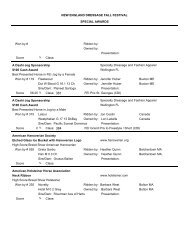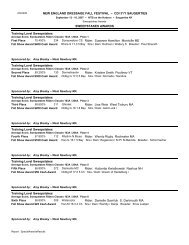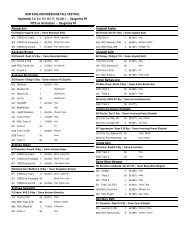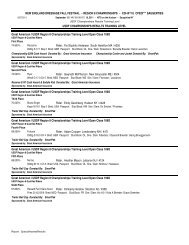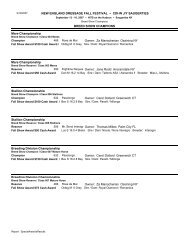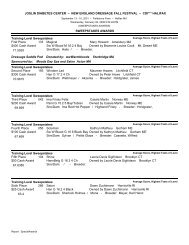NEDA Fall Festival 2011 - New England Dressage Association
NEDA Fall Festival 2011 - New England Dressage Association
NEDA Fall Festival 2011 - New England Dressage Association
You also want an ePaper? Increase the reach of your titles
YUMPU automatically turns print PDFs into web optimized ePapers that Google loves.
The Yin and Yang of It<br />
Arthur Kottas-Heldenberg Comes to <strong>New</strong> <strong>England</strong><br />
Hurricane Irene brought more to <strong>New</strong> <strong>England</strong> than high<br />
winds and massive rainfall. Preceding it by a day,<br />
Arthur Kottas-Heldenburg arrived at Kenridge Farm in<br />
Kensington, NH, for a 4 day clinic on Friday, August 26th.<br />
Both events were not anticipated by much time, but Herr<br />
Kottas was, unlike Irene, fortuitous. Despite the ominous<br />
forecasts, the clinic was uninterrupted by the weather, and<br />
Herr Kottas, or Arthur, as he was quick to encourage participants<br />
to call him, was the far more potent force. Irene was<br />
downgraded to a mere storm by a master of dressage, and a<br />
brilliant teacher.<br />
Irene Greenberg organized the<br />
clinic in exemplary fashion, having<br />
been informed by a dressage friend in<br />
Canada that Arthur had 2 days free,<br />
and possibly 4, after a clinic in<br />
Toronto. With very little time at her<br />
disposal, she contacted as many people<br />
as possible, utilizing Facebook<br />
and the <strong>NEDA</strong> website. The results<br />
were excellent; the clinic was filled<br />
with a combination of dressage professionals<br />
and individual riders, and<br />
Arthur was able to show his talent in<br />
instructing a varied group of riders, and demonstrating the training<br />
protocol with a heterogeneous group of horses.<br />
It was immediately evident that Arthur has an inner core<br />
of classical dressage principles with which he would teach<br />
and train, applying to each rider and horse. He exemplified<br />
the commitment to the concept that these principles should<br />
be applied at the very beginning of a horse’s training to make<br />
it easier for the horse to advance to the higher levels of collection<br />
while retaining the suppleness and elasticity of the<br />
basic gaits that we see, or hope to see, in young horses. He<br />
consistently urged the riders and auditors to consider the<br />
“why” as well as the “how” of training: to lengthen the stride<br />
of the gait, the back must be relaxed and the movement<br />
should swing through it; to allow this to happen, the rider<br />
should lighten the seat and allow the horse to stretch its<br />
topline. Without a relaxed back that can swing, the engagement<br />
cannot develop. Without the engagement, collection<br />
becomes a shortening of the gait without a lowering of the<br />
croup. Without the raising of the forehand, the lowering of<br />
the croup is not possible without tension, which destroys the<br />
gait. Yin and yang. The horse should be ridden with a positive<br />
encouragement to contract the inside muscles of his body,<br />
i The <strong>New</strong> <strong>England</strong> <strong>Dressage</strong> <strong>Association</strong> j<br />
� BY ALEXANDRA DANE �<br />
He exemplified the commitment to<br />
the concept that these principles should<br />
be applied at the very beginning of a<br />
horse’s training to make it easier for the<br />
horse to advance to the higher levels of<br />
collection while retaining the suppleness<br />
and elasticity of the basic gaits that we<br />
see, or hope to see, in young horses.<br />
so that movements such as shoulder-in and half-pass are not<br />
initiated by an inside rein. To do so requires that the rider<br />
allow the stretching and relaxation of the outside muscles of<br />
the horse’s body: yin and yang. Most important of all, judging<br />
by the earnest and heartfelt emphasis Arthur repeatedly<br />
placed on it: the horse provokes a rider’s reaction, just as a<br />
rider provokes the horse’s reaction – yin and yang. To ignore<br />
this principle is to ignore classical dressage training.<br />
Through all the intense teaching and focus on educating<br />
the riders while improving the horses, Arthur retained and<br />
demonstrated a whimsical sense of humor and an empathy for<br />
his riders and horses. While I<br />
was not able to be present at all<br />
sessions, the reaction that I heard<br />
was positive and very enthusiastic.<br />
Arthur demonstrated in-hand<br />
work on Saturday evening; I regret<br />
that I yielded to my husband’s<br />
heartfelt pleas that I not venture<br />
out, and did not attend. Still,<br />
Arthur worked several horses in<br />
hand on all days of the clinic, so<br />
that I have a feeling for what his<br />
work sets out to accomplish.<br />
What makes him a master is his ability to sense that the horse<br />
is within a stride or two of giving the correct response, and<br />
then praising him AS he is doing so; a training aid that is<br />
more than effective, it is a game-changer.<br />
Arthur Kottas-Heldenberg will be returning for clinics at<br />
Kenridge Farm. He enjoyed working with the participants,<br />
and found <strong>New</strong> <strong>England</strong> a hospitable and welcoming venue.<br />
We are grateful that we will have the opportunity to have him<br />
available in the future. The information will be posted on the<br />
<strong>NEDA</strong> website, and you can contact Irene at irene.e.greenberg@gmail.com.<br />
Z<br />
24 To become a <strong>NEDA</strong> member visit our website at: www.neda.org



